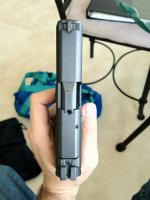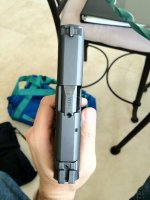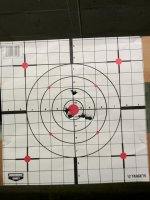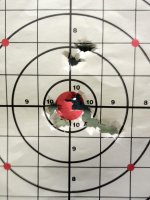That video by Todd Jarret is an excellent choice to establish a starting point. However, it's not at all or uncommon to deviate a bit from this starting point due to your individual needs.
For example when Todd ages a bit more he'll drop that advice about "crystal clear" sights and start advocating Point Shooting. It's an unfortunate aspect of getting older, most of us lose the ability to focus on objects held close to us and reading glasses throw a target so far out of focus that you lose too much detail in the target.
Finger placement on the trigger is another area where some deviation can be expected. Peoples hands can range from those with large palms with short stubby fingers to those of a pianist with smaller palms and long slender fingers. It's why many custom grip makers back in the day of revolvers would require a hand tracing before starting on a custom grip. One unfortunate aspect of many modern handguns is that they feature "one size fits all" grips that force us to stray a bit from what would be considered ideal.
First, a definition. The pad on the end of your finger with the "fingerprint" is called the Distal Pad. I've found from lots of experiments and shooting with double action revolvers that what works best for me. I draw an imaginary line half way between the Center of the distal pad and the crease of the first joint. This imaginary line is then placed so that it's centered on the trigger. Depending on the width of the trigger this means that the first crease is at the side of the trigger or actually partly engaged on the trigger with wide target triggers. If you want a good place to start, try using a pen or your mide to draw a line on your finger in this position.
Next, do what you have been doing. That is pull the trigger with snap caps in your gun and watch for movement in the sights during the trigger stroke. BTW, this is one reason why I believe Revolvers are the finest handguns for training on the planet, they allow you to observe your sights while making a LONG trigger stroke. What you then want to do is experiment with your finger placement until you find a position that produces the LEAST disturbance in the sights FOR YOU.
BTW, you also want to make sure to watch your sights at the very end of the trigger stroke as the trigger breaks. If you find that your sights jerk just as the hammer drops it's a clear indication that you are "jerking" the trigger at the very end to force the break. This is most likely the single most difficult habit to break and until you learn to "allow" the trigger to break without any jerk you'll keep throwing out "flyers". BTW, no striker or hammer on the planet has enough power to cause the gun to jerk when it drops, so those who claim that their finishing jerk is due to the hammer dropping are misleading themselves and unwilling to admit they have a habit that needs correction.
Finally, IMO people are a bit over concerned about the gun being perfectly aligned with the bones in the forearm. The simple truth is that this alignment is nearly impossible from an isocelles stance because you have to place your elbow on your sternum, a rather unstable position. Perfect alignment can only be achieved naturally one hand from a Duelists Stance. So, use alignment as a starting point only and adapt as needed to the way your body requires.




